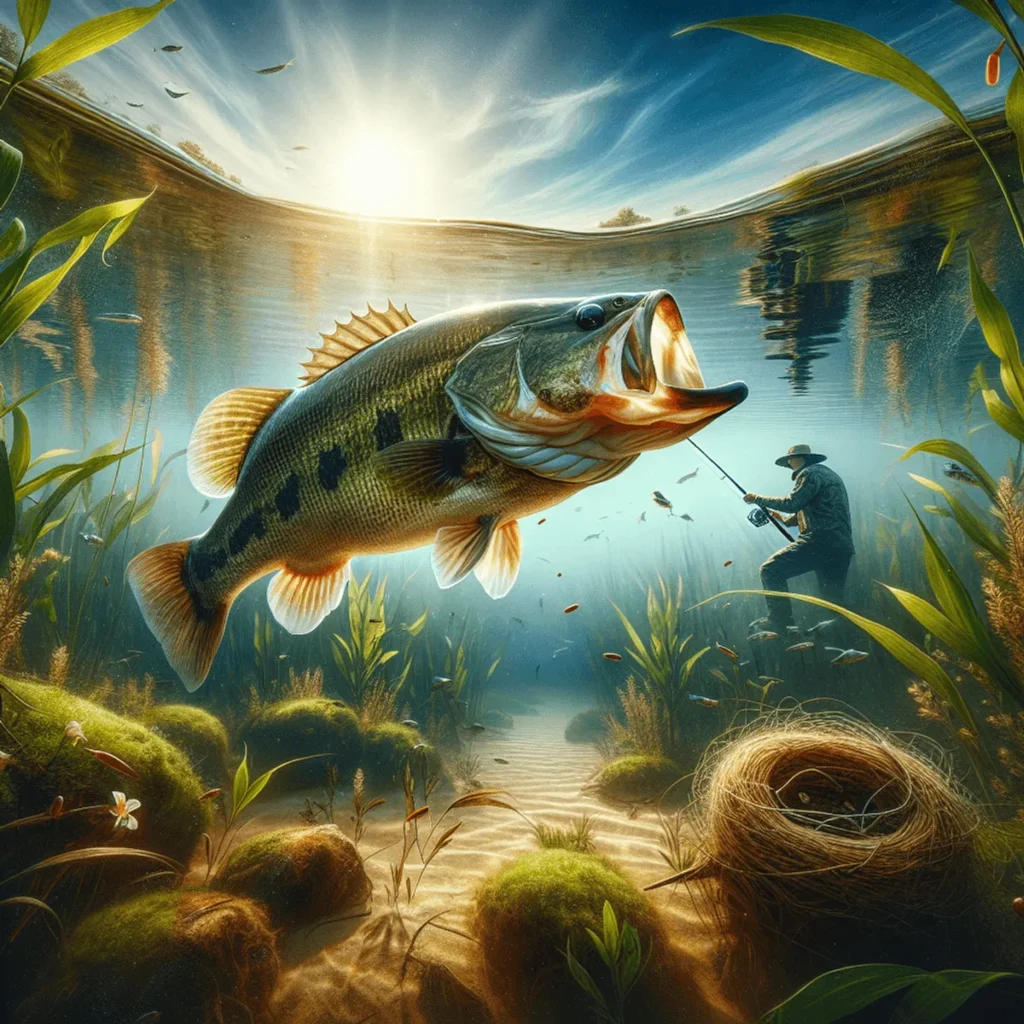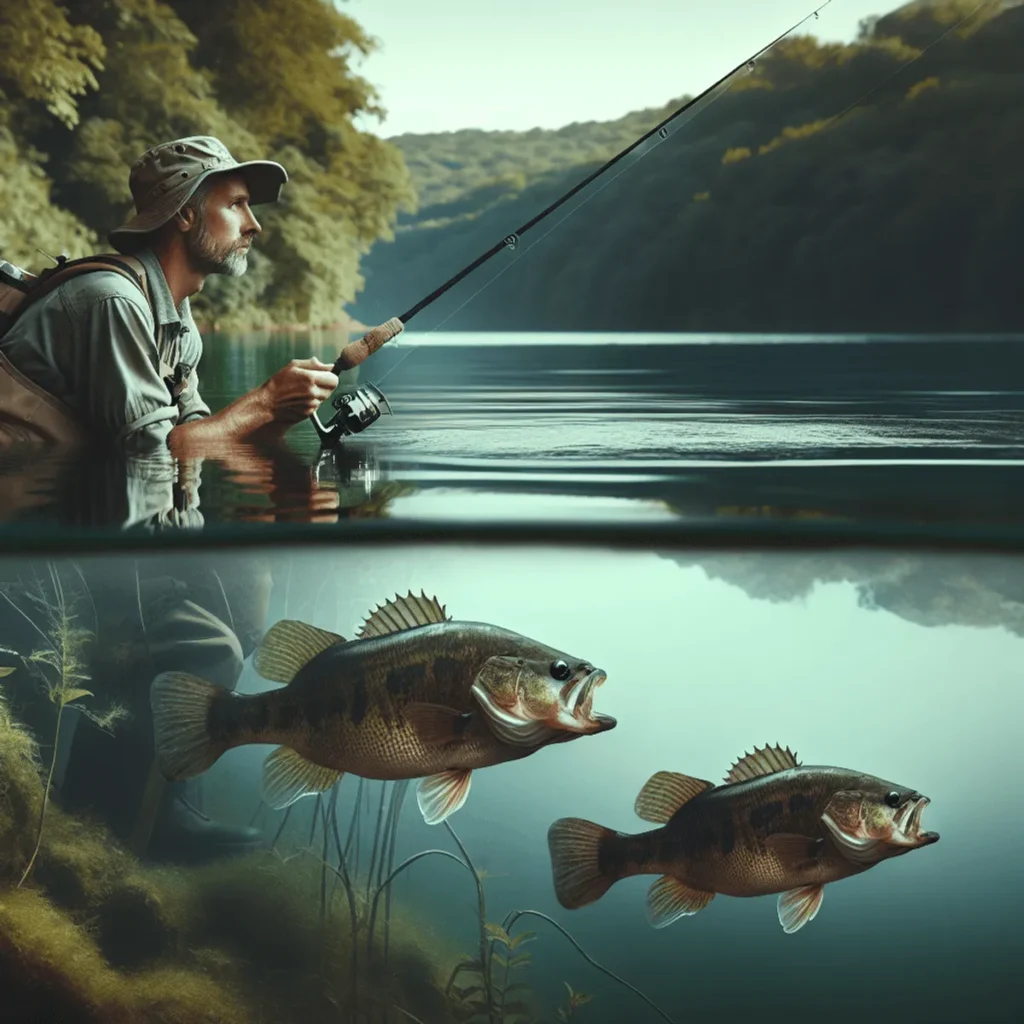When it comes to freshwater fishing, two species stand out: Largemouth Bass and Smallmouth Bass. Both belong to the sunfish family and are highly sought after by anglers for their unique characteristics and thrilling catch experiences. Understanding the differences between largemouth bass and smallmouth bass is essential for any angler looking to maximize their success on the water.
Largemouth Bass
Largemouth bass (Micropterus salmoides) are known for their impressive size and aggressive behavior. They can weigh up to 22 pounds, making them a formidable opponent. Their distinctive greenish coloration and mouth that extends past their eye make them easily recognizable.
Smallmouth Bass
On the other hand, smallmouth bass (Micropterus dolomieu) are celebrated for their feisty nature and agility. Though they might be smaller, typically weighing between 2-4 pounds, their brown or bronze color and smaller mouth set them apart.
Anglers need to understand these differences to tailor their strategies effectively. Catching each species requires different techniques, knowledge of their habitats, and awareness of their behavioral traits. These insights can significantly enhance your fishing experience, making every trip both challenging and rewarding.
In this fishing showdown between largemouth bass vs smallmouth bass, we delve into physical differences, habitat preferences, behavioral traits, fishing techniques, spawning habits, popular fishing locations across the U.S., and best practices for targeting both species successfully.
Physical Differences Between Largemouth and Smallmouth Bass
When comparing the largemouth bass and smallmouth bass, their physical characteristics stand out significantly, impacting both identification and fishing strategies.
Size Comparison
- Largemouth Bass (Micropterus salmoides): Typically larger, ranging from 3-7 pounds. The heaviest recorded largemouth bass weighed an impressive 22 pounds 4 ounces.
- Smallmouth Bass (Micropterus dolomieu): Generally smaller, with most weighing between 2-4 pounds. The record for the largest smallmouth bass is 11 pounds 15 ounces.
Mouth Shape
- Largemouth Bass: As the name suggests, largemouth bass feature a mouth that extends past their eye. This distinct trait makes them easily identifiable.
- Smallmouth Bass: In contrast, the mouth of a smallmouth bass does not extend beyond the eye, giving them a more compact appearance.
Coloration
- Largemouth Bass: Display a greenish hue with dark blotches forming a horizontal stripe along each flank.
- Smallmouth Bass: Exhibit shades of brown or bronze, often with vertical stripes or bars on their sides.
These differences are crucial for anglers aiming to distinguish between these two popular species. Recognizing these traits can enhance your fishing expeditions by helping you target the right fish in appropriate environments.
Habitat Preferences: Where to Find Largemouth and Smallmouth Bass
Understanding where largemouth and smallmouth bass like to live is crucial for any angler. Each type of bass thrives in different environments, which greatly affects your fishing strategies.
Largemouth Bass Habitat
1. Preferred Water Conditions
Largemouth bass are usually found in warmer waters, preferring murky lakes and slow-moving rivers. These places offer plenty of hiding spots like plants, stumps, and rocks where largemouth can surprise their prey.
2. Geographical Distribution
Because they can live in so many different places, largemouth bass can be found in almost every state in the U.S., making them one of the easiest fish to target for anglers.
Smallmouth Bass Habitat
1. Preferred Water Conditions
On the other hand, smallmouth bass like cooler waters with clear conditions. They often hang out in rocky bottoms and areas with strong currents like rivers and deep lakes. These settings suit their active hunting style.
2. Geographical Distribution
Smallmouth bass aren’t as widespread as largemouths but can still be found in many U.S. states, except Louisiana and Florida. Their love for cooler water means they’re usually found in northern regions and higher altitudes.
Read Also: Braided Line vs Mono: Pros, Cons, and When to Use Each
Comparison of Habitats
The different living environments of these fish require various fishing methods:
- When going after largemouth bass, you might use techniques that take advantage of their love for cover, such as casting near plants with topwater lures or jigs.
- For smallmouth bass, concentrating on rocky areas with clear water will give you better results using gentle tactics like drop-shots or soft plastics.
Knowing where these fish prefer to live improves your chances of finding and catching each type effectively, adjusting your fishing methods to fit their natural surroundings.
Behavioral Traits: How Largemouth and Smallmouth Bass Differ in Their Actions

Understanding the behavioral differences between largemouth bass and smallmouth bass is crucial for successful angling.
Largemouth Bass as Ambush Predators
Largemouth bass are classic ambush predators. They rely on stealth and patience, often hiding among vegetation, stumps, or submerged structures until an unsuspecting prey comes within striking distance. This behavior makes them particularly receptive to:
- Topwater lures: Frogs and poppers can be effective when fished near cover.
- Jigs: Especially useful in dense vegetation where largemouths lurk.
Smallmouth Bass as Active Hunters
In contrast, smallmouth bass are active hunters. They prefer to chase down their prey, often swimming in clear waters with rocky bottoms where they can use their excellent vision to spot potential food sources. Techniques that work well include:
- Spinnerbaits: Ideal for covering large areas quickly.
- Crankbaits: Effective in mimicking baitfish in various water conditions.
Differences in Feeding Behaviors
Feeding behaviors also differ significantly between these two species:
- Largemouth Bass: Tend to use vibrations to locate prey. This makes them more likely to respond to lures that create substantial movement or noise.
- Smallmouth Bass: Primarily rely on sight when hunting. Clear water conditions enhance their ability to spot and chase bait, making finesse tactics like drop-shots particularly effective.
Recognizing these behavior differences allows you to tailor your fishing strategies effectively, ensuring a more productive and enjoyable experience on the water.
Read Also: Which is Better? British vs American Fly Fishing
Fishing Techniques: Strategies for Catching Largemouth and Smallmouth Bass Successfully
Understanding the specific fishing techniques for each bass species can significantly enhance your success rate. Here are some detailed strategies:
Effective Techniques and Best Lures for Catching Largemouth Bass
Topwater Lures
Frogs: Particularly effective during late spring and early summer, mimicking the movement of prey on the water’s surface.
Poppers: Great for creating noise and attracting largemouth in murky waters.
Jigs
Flipping Jigs: Ideal for fishing in heavy cover such as vegetation or submerged structures.
Swim Jigs: Effective in open water, providing a versatile option that imitates baitfish.
Effective Techniques and Best Lures for Catching Smallmouth Bass
Finesse Tactics
Drop-Shots: Excellent for clear waters where subtle presentation is key. Use soft plastic baits to attract smallmouths.
Ned Rigs: Effective in rocky bottoms and areas with less vegetation, providing a slow-fall presentation.
Spinnerbaits
Particularly useful in swift waters, as they create vibrations and flash that attract smallmouths.
Crankbaits
Effective in both shallow and deeper waters, especially when targeting active hunters like smallmouth bass.
Situational Fishing Methods Based on Water Conditions
Murky Waters
Use lures that create noise or vibrations to help bass locate them. Topwater lures and spinnerbaits are excellent choices here.
Clear Waters
Opt for more subtle presentations such as drop-shots and finesse jigs. Natural-colored baits work best to avoid spooking the fish.
Understanding these techniques and selecting the right lures based on water conditions will significantly improve your chances of catching both largemouth and smallmouth bass effectively.
Spawning Habits: Understanding the Reproductive Behaviors of Largemouth and Smallmouth Bass

Spawning preferences of Largemouth Bass
Largemouth bass spawn in warmer waters, usually between the upper 70s to mid-80s Fahrenheit. They look for shallow, vegetated areas to make nests by digging depressions in the bottom. The males fiercely guard these nests until the young fish hatch and swim away.
Spawning preferences of Smallmouth Bass
Smallmouth bass, however, prefer cooler waters for spawning. Their ideal temperature range is from mid-60s to mid-70s Fahrenheit. These fish like rocky or gravelly bottoms to build their nests, often picking spots with some current. Like largemouths, male smallmouths also watch over their nests closely during the incubation period. Fly fishing for smallmouth bass can be a rewarding experience, especially when done in their preferred spawning habitats.
Popular Fishing Locations for Targeting Largemouth and Smallmouth Bass Across the U.S.
Top Fishing Spots for Largemouth Bass
- Lake Okeechobee, Florida: Known as the “Big O,” this lake offers prime conditions for largemouth bass, with abundant vegetation and warm waters.
- Lake Erie, Ohio/Pennsylvania/New York: Despite its reputation for smallmouth bass, Lake Erie’s shallow bays and weed beds are also hotspots for trophy-sized largemouths.
- Sam Rayburn Reservoir, Texas: This reservoir is a go-to destination for largemouth enthusiasts, featuring plenty of submerged timber and brush piles.
Top Fishing Spots for Smallmouth Bass
- St. Lawrence River, New York: Famous for its clear waters and rocky bottoms, making it a premier location for catching sizable smallmouth bass.
- Tennessee Valley Authority (TVA) Lakes: The TVA system includes Chickamauga Lake and Dale Hollow Lake, both renowned for their thriving smallmouth populations due to optimal water conditions.
- Lake Champlain, New York/Vermont: Straddling the border between New York and Vermont, this lake is celebrated for its diverse habitats that support robust smallmouth bass fisheries.
Exploring these top locations will significantly elevate your fishing experience by targeting each species in their ideal environments.
Best Practices for Anglers When Targeting Both Species Effectively
Essential Gear Recommendations
Using the right gear is crucial for a successful bass fishing experience. Trusted tackle brands like Shimano and Rapala offer high-quality rods, reels, and lures tailored to both largemouth and smallmouth bass.
Rods and Reels
Shimano’s spinning and baitcasting reels are renowned for their durability and smooth performance. Pair them with medium-heavy rods for largemouth bass and medium-light rods for smallmouth bass.
Lures
Rapala’s range of crankbaits and soft plastics are effective for both species. Experiment with different colors and sizes based on water clarity and fish behavior.
Read Also: Best Hook Size for Surf Fishing: Find Your Perfect Match
Tackle Selection Tips
Selecting the right tackle can make a significant difference:
- Line Weight: Use a heavier line (12-20 lb test) when targeting larger largemouth bass to handle their size and strength. For smallmouth bass, a lighter line (6-10 lb test) ensures better sensitivity and lure action.
- Hooks and Weights: Opt for strong, sharp hooks from brands like Gamakatsu or Owner. Adjust weights based on fishing depth; heavier weights help maintain lure depth in deeper waters.
Strategies to Maximize Success
Maximizing success involves understanding seasonal patterns and adapting your approach:
- Seasonal Awareness: Bass behavior changes with seasons. Spring is ideal for pre-spawn activity, while summer focuses on deeper waters.
- Adaptability: Be ready to switch tactics based on water conditions. Topwater lures work well in murky waters; finesse techniques excel in clear conditions.
These practices ensure you are well-equipped to target both largemouth and smallmouth bass effectively, enhancing your overall fishing experience.
Conclusion: Which Type Of Fish Is Superior For Fishing Experiences?

When you compare Largemouth and Smallmouth Bass, the choice often comes down to personal preference. Will Brantley, a renowned angler, states:
“For those who enjoy the thrill of a fierce fight, Smallmouth Bass provides unmatched excitement. But if you’re after size and power, Largemouth Bass is your best bet.”
Both species offer unique challenges and rewards. The decision on which is superior for fishing experiences depends on what you value more in your angling adventures—size and power or agility and fight.
FAQs (Frequently Asked Questions)
What are the main physical differences between Largemouth and Smallmouth Bass?
Largemouth Bass typically have a larger mouth that extends past their eyes, while Smallmouth Bass have a smaller mouth that does not extend past their eyes. Additionally, Largemouth Bass are generally larger in size, averaging between 1 to 10 pounds, whereas Smallmouth Bass usually weigh between 1 to 5 pounds.
Where can I find Largemouth and Smallmouth Bass?
Largemouth Bass prefer murky lakes and slow-moving rivers with warmer waters, while Smallmouth Bass thrive in cooler waters with rocky bottoms. Understanding these habitat preferences can help anglers strategize their fishing locations effectively.
How do the feeding behaviors of Largemouth and Smallmouth Bass differ?
Largemouth Bass are ambush predators that rely on stealth and vibrations to catch their prey, often hiding in cover. In contrast, Smallmouth Bass are active hunters that pursue their food visually, making them more aggressive in open water.
What are some effective fishing techniques for catching Largemouth and Smallmouth Bass?
For Largemouth Bass, effective techniques include using topwater lures and jigs. For Smallmouth Bass, finesse tactics like drop-shots work well. It’s important to adjust your methods based on water conditions for optimal results.
What are the spawning habits of Largemouth and Smallmouth Bass?
Largemouth Bass prefer to spawn in warmer temperatures, typically around 65-75°F, while Smallmouth Bass spawn in cooler temperatures ranging from 60-70°F. Understanding these preferences can aid anglers in timing their fishing trips.
Which species is considered superior for fishing experiences?
The preference between Largemouth and Smallmouth Bass often comes down to personal choice. Some anglers prefer the fight and behavior of Smallmouths in cooler waters, while others enjoy the size and strength of Largemouths. Experts like Will Brantley often share insights based on their personal experiences with both species.




